 USA (1890-94): Protected Cruiser C-12 Columbia, C-13 Minneapolis 1894-1921
USA (1890-94): Protected Cruiser C-12 Columbia, C-13 Minneapolis 1894-1921WW1 and prewar USN Cruisers
Atlanta class | USS Chicago | USS Newark | USS Charleston | USS Baltimore | USS Olympia | USS Philadelphia | USS San Francisco | Cincinatti class | Montgomery class | Columbia class | New Orleans class | Denver class | Chester class | Omaha classUSS New York | USS Brooklyn | Pennsylvania class | Saint Louis class | Tennessee class
The Columbia-class were two protected cruisers started in 1890 and 1891 at Cramp for the United States Navy. They were an interesting take on the concept of commerce raiders, as protected cruisers (moderate armour) lightly armed for their size which focus was on speed to overtake and destroy fast ocean liners first and foremost. This light armament and armor however both inspired other navies, but was later criticized as being too specialized. They were outclassed by similar sized protected cruisers, not speaking of armoured cruisers, albeit their superior speed would allow them to engage when choosing so. The ships were also not good steamer and at full speed, their long range quickly dwidled down. As for ocean liners from 1907 they would be left behind by the new generation such as the Lusitania or German Kronprinzessin Cecilie. They took part in WWI after some modernization and were discarded in 1921.

USS Minneapolis, prow view
Development
In 1888, the “new navy” was just in full swing. The small size of the USN by then led to several concepts. Some were inspired by the “Jeune Ecole”, but without the focus on torpedo boats. One of these, present from the start, was to develop a way to harm a potential enemy’s trade lines. For this, it was advocated to build commerce raising cruisers. US Representative Charles A. Boutelle of Maine became the advocate in Congress of such specialized commerce raiders but met resistance and critcism, including by the Navy. It managed to overcome this opposition eventually, and obtained an order to William Cramp & Sons of Philadelphia as sole bidder for the first of these, USS Columbia, ordered FY1891.
Minneapolis was ordered FY1892 and was dubbed the “most important ship” for that year. Boutelle of course wanted the ships to built at Bath Iron Works naval yard in Bath, Maine, and despite being the lowest bidder, Bath could not build their own engines nor complete these in the specified schedules. The contract went to Cramp instead, providing their make a lower bid down to $55,000.
The ships were built over 3-4 years, Minneapolis being faster to build (From Dec. 1891 to Dec. 1894).
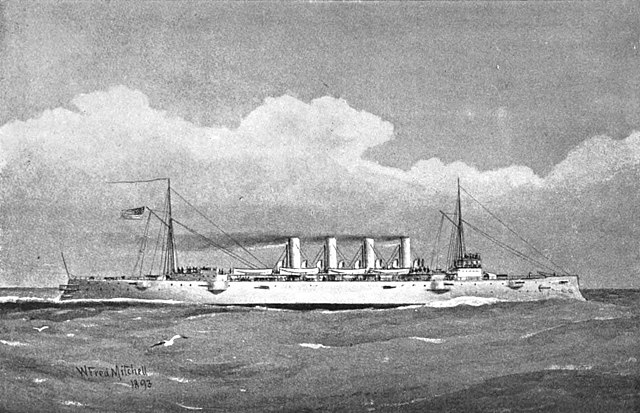
Depiction of the class in Brasseys
Design
Hull and general design
The Columbia class were large ships, with a displacement of 7,375 long tons (7,493 t), an overall lenght of 412 ft (126 m) to the tip of the spur ram, a beam of 58 ft 2.25 in (17.74 m) with limited tumblehome, a popular feature at the time, and a generous draft of 22 ft 6.5 in (6.87 m) for stability. Their silhouette was very unique. They resembled the liners they were supposed to catch, with their elongated, tall flush deck hull, four raked funnels heavenly spaced and two masts, short foredeck and poop deck. Only their ram and sloped down poop were a giveaway as they had a straight stem and clipper poop. Thius was partly due to their armament, light and mostly placed in side sponsons.
Powerplant
The engineering plant was a monster, as it was to be capable of meeting the specified 22.5 knots (41.7 km/h; 25.9 mph)top speed, never seen in the USN in 1889. Engineer-in-Chief George W. Melville was at hte head of the desigh team to achieve this, calculating a required output of 21,000 ihp (16,000 kW), which at the time was almost double that of the battleship USS Iowa. This was even well above the Brooklyn’s 16,000 ihp (12,000 kW), an armoured cruiser.
This was a triple-propeller powerplant, a unique arrangement in the US Navy and between eight and ten (sources generally says 8 for Columbia, 10 for Minneapolis) coal-fired cylindrical boilers were installed. They provided steam to triple-expansion engines so that they could economically cruise at 15 knots (28 km/h; 17 mph) on the center engine alone when transiting to their station. Eager to obtain a bonus, the engineering team in fact went boyond expectations and the ships did well on trials, Columbia reaching 22.8 knots (42.2 km/h; 26.2 mph), Minneapolis 23.07 knots (42.73 km/h; 26.55 mph), but of couse on light, unrealistic displacement.
Consideration was given to survivability, by default of a better armour, in case of battle damage, and this was another innovation of this design. Each engine had its own separate compartment, he center propeller being 15 ft (4.6 m) aft of the outboard ones enabled this staggered installation. This minimized chance of disabling more than two propulsion units in case of a single hit.
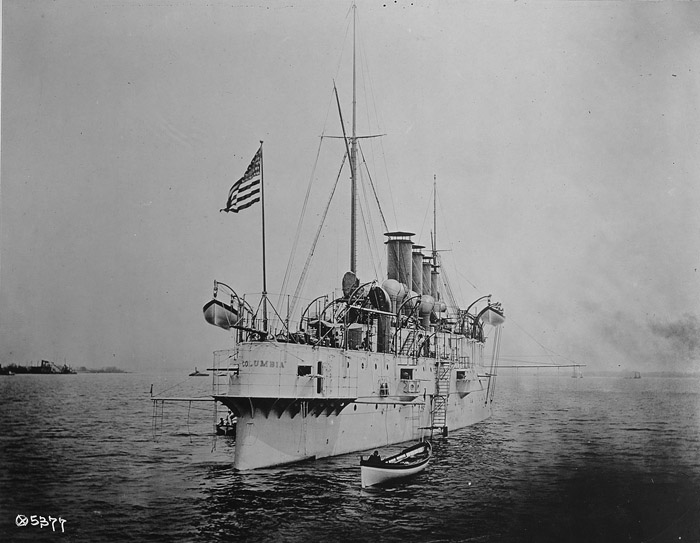
Stern view of USS Columbia as completed, NARA
Not only the ship diverged in the number of boilers, but also in appearance, with Columbia having four funnels and Minneapolis two, explained by the way the boilers were arranged and truncated. The line-like” ruse only worked up to some point, useful gunnery range. In normal conditions they carried 800 tons of coal, which could be extended to 2,130 tons for a wooping 25,520 nmi (47,260 km; 29,370 mi) at 10 kn (19 km/h; 12 mph) to reach their distant station. At least this was whant was noted, but it seems grossly impractical. Full load coal allowance is noted 1,576 tons however. It was not uncommon for ships to carry several times more coal than intended, as shown by the Pacific squadron’s expedition.
In July 1895, USS Columbia made a transatlantic crossing, from Southampton to Sandy Hook. This was done in a record 6 days, 23 hours, 49 minutes with 18.41 knots on avrerage and without forced. At the time it was the world’s fastest crossing for a warship at least ion that distance. The British Turbinia in 1897 would be much faster at 34.5 knots (63.9 km/h; 39.7 mph). For the record, it was held by the German Hamburg America Line’s Fürst Bismarck in 6 days, 10 hours, 32 minutes.
Protection
The Columbia class had an armored deck standard for protected cruisers, turtledeck with the sloped being 4 inches (102 mm) and flat section at 2.5 in (64 mm) inches (flat middle). There were gun shields of 4 inches or 102 mm as were the 4-inches guns sponsons.
The conning tower forward had wall 5 inches (127 mm). This was in the norm for protected cruisers, but they were very large ships and this was light for their size.
Armament
The Columbia’s main armament comprised four 6-inches (152 mm)/40 caliber guns: Two forward and two aft originally.
However it was decided by the naval staff to replace the aft pair by a single 8 inches (203 mm)/40 caliber Mark III or V gun (probably later).
This left only two 6-inch guns side by side forward of the superstructure.
The secondary armament included eight 4 in (102 mm)/40 caliber rapid fire (RF) guns. They were placed on sponsons along the hull.
They were interleaved with twelve 6-pounder (57 mm (2.2 in)) RF guns as well as four 1-pounder (37 mm (1.5 in)) RF guns, four Gatling guns that couldbe deployed by a landing party if needed and completed by a field artillery piece on a wheeled carriage. They were also given four torpedo tubes, 14-inches (356 mm) for USS Columbia (Howell torpedoes) and 18 inches (450 mm) on Minneapolis. The former were short ranged and defensive, not the ones on Minneapolis.
8-inch/40-caliber gun Mark 5 (1894)
The 8″/40 (20.3 cm) Mark 5 was a derivative of the earlier 8″/35 (20.3 cm) Marks 3 and 4, widespread on cruisers and battleships of the era. These were derivatives of the earlier 8″/30 (20.3 cm) guns. The Mark 5 was a new 40 caliber design for armored cruisers and battleship secondaries. It featured a barrel with muzzle bell and proved unable to handle the transition from black powder to nitrocellulose propellants, causing pressure concerns. This happened on USS Colorado (ACR-7) which blew a muzzle in gunnery practice off Chefoo by 1907. Mark 5 guns were lengthened to 45 calibers (new liner) with tubes re-hooped to the muzzle. Called Mod 1 they were not reinstalled but placed into reserve. Later the Mod 2 appeared with a reworked breech mechanism and gas seat. The 40 calibers were only shared by the Pennsylvania (ACR-4) and Columbia (C-12) classes.
Specs:
c30,000 lbs for a 343.0 in (8.712 m) barrel, 320 in (8.128 m) bore length.
Shell: 260 lbs. (118 kg) AP or common HE
Muzzle velocity 2,500 fps (762 mps)
Range 16,000 yards (14,630 m) at 20°
Rate of fire: 0.5 to 0.8 rounds per minute
6-inch/40-caliber gun Mark 4
These new guns were designed in 1883 and produced from 1896 (until 1905). They were the more modern 6-inches in use in the USN. These guns equipped also early USN Battleships, USS Indiana, Massachusetts, Oregon, Illisnoise and Alabama, Wisconsin. The only cruisers which featured them were Cincinatti and Raleigh.
Specs: 13,370 lb (6,060 kg) without breech, Mod 0 256.1 in (6,500 mm).
Barrel length: 240 in (6,100 mm) bore (40 calibers).
It fired shells weighting 105 lb (48 kg) naval armor-piercing models.
Traverse: −150° to +150°.
Rate of fire: 1.5 rounds per minute, muzzle velocity 2,150 ft/s (660 m/s).
Effective range: 9,000 yd (8,200 m) at 15.3° elevation.
5-inch/40 (127 mm) Mark 2
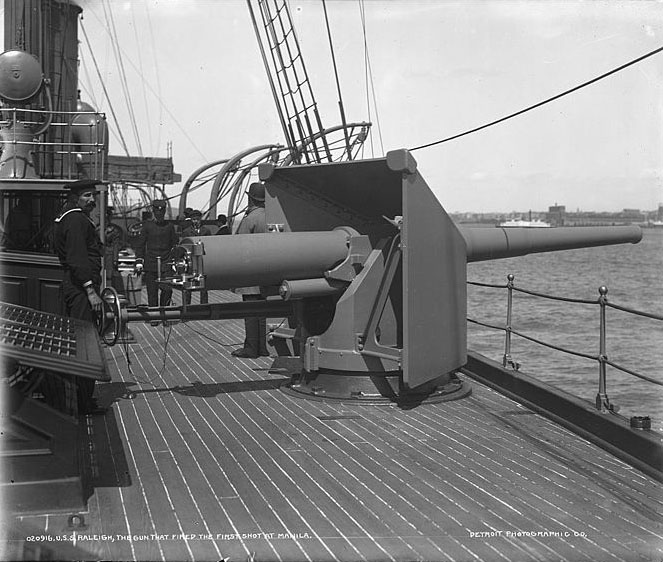
68 Mark 2 were built, and they weighted 7,000 lb (3,200 kg) without breech and 7,080 lb (3,210 kg) with breech.
The Barrel length was 200 in (5,100 mm) bore (40 calibers). −150° to +150°, open mount with shield.
Rate of fire: 12 rounds per minute, muzzle velocity 2,300 ft/s (700 m/s).
Effective firing range: 8,500 yd (7,800 m) at 15° elevation.
6-pounder (57 mm (2.2 in)) Driggs-Schroeder Mk I/II
Four of them, located in hull casemates fore and aft. 57x307R, 25 rpm, mv 1,818 feet per second (554 m/s) max range 4,000 yards (3,700 m).
3-pounder (47 mm (1.85 in)) Driggs-Schroeder Mk I/II
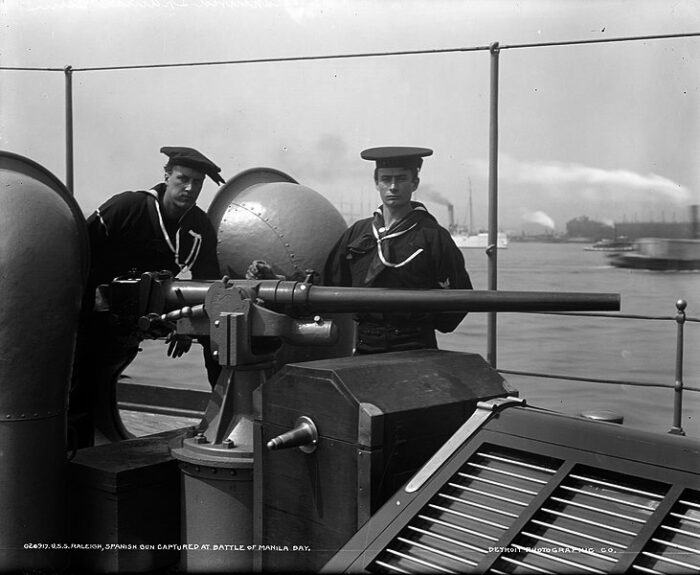
Four, located in the upper platforms on the roof of the main casemates fore and aft. Fixed QF 47×376 mm R 3 kg (6.6 lb), 30 rpm mv 571 m/s (1,870 ft/s) range 5.9 km (3.7 mi) at +20°.
1 pdr Driggs-Schroeder Mk I
Two 1-pounder (37 mm (1.5 in)) Hotchkiss revolving cannon located in the fighting tops alongside the two .45 caliber (11.4 mm) Gatling guns.
Similar to the British water-jacketed guns, rapid fire. The gun was originally a scaled up Maxim machine gun (Maxim-Nordenfelt 37 mm). It was belt fed, up to 300 rpm cyclic. mv 1,800 ft/s (550 m/s and max range 4,500 yards (4,110 m).
Upgrades
1904: Removal of all torpedo tubes.
Long decommission (Columbia 1907–1915, Minneapolis 1906–1917).
Re-activation refits: 8-in gun replaced by a third 6-in(152 mm)/40 (other source c1906)
1917: Two 4-inch guns removed. Potentially two more 4-inch guns removed.
1918: Two 3-inch (76 mm)/50 AA added.
Navypedia specifies these ships received four 4-in/40 Mark 6 and two 3-in/52 Mark X guns in WW1.

Author’s old illustration
⚙ specifications |
|
| Displacement | 7,375 long tons (7,593 t) standard |
| Dimensions | 412 ft x 58 ft 2.25 in x 22 ft 6.5 in (126 x 17.74 x 6.87 m) |
| Propulsion | 3× VTE engines, 8-10 steam boilers, 21,000 ihp (16,000 kW) |
| Speed | 22.5 knots (41.7 km/h) |
| Range | 25,520 nmi (47,260 km; 23,370 mi) at 10 kn (19 km/h; 12 mph) |
| Armament | 1x 8-in/40, 2× 6 in/40, 8× 4 in/40, 12× 6-pdr, 4× 1-pdr, 4× Gatling gun, 4× 14 in TTs |
| Protection | Deck 4 in (102 mm), CT 5 in (127 mm), sponsons 4 in (102 mm), shields 4-in (102 mm) |
| Crew | 30 officers and 447 enlisted |
Career of USS Columbia and Minneapolis
 USS Columbia (C-12)
USS Columbia (C-12)
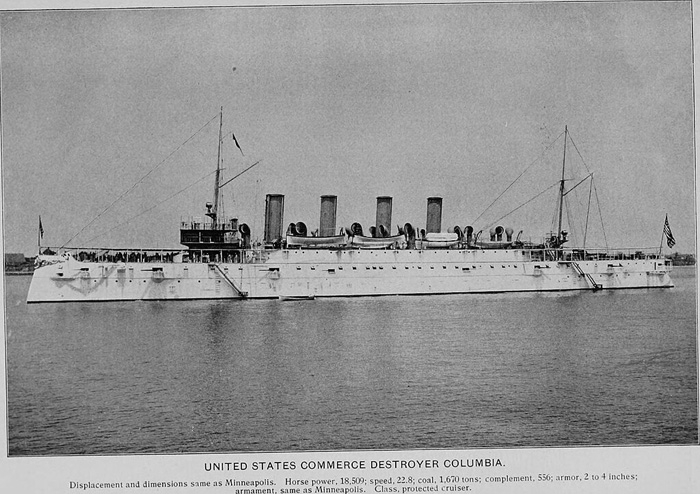
USS Columbia, Cramp Shipyard official booklet photo
USS Columbia was laid down at William Cramp & Sons, Philadelphia in Pennsylvania, on 30 December 1890. She was launched on 26 July 1892 and commissioned on 23 April 1894, assigned to the North Atlantic Squadron. From 30 July 1894 up to 5 January 1895 she sailed in the Caribbean and covered the intervention in Nicaragua in July-August 1894. She visited Europe the next summer in 1895, and was in Kiel for the opening of the canal, representing the United States, in June. Back in August she remained in training along the western Atlantic in 1895-96 before being placed in reserve at Philadelphia Navy Yard, 13 May 1897.
On 28 April 1896, while moored at Newport News she collided with the drifting passenger steamer Wyanoke, which sank. 2 passengers and a crewman drowned.
USS Columbia was recommissioned on 15 March 1898 as the Spanish–American War broke out. At first she was assigned patrols on the Atlantic coast in case of a sortie of the Armada from Spain, and she was sent in West Indies until 26 August to intercept possible reinforcements (and Montojo’s fleet). She was tasked to protect troops convoys also to Puerto Rico and covered its occupation until 14 August. When the war was over, she was decommissioned, placed in reserve at Philadelphia NyD, 31 March 1899.
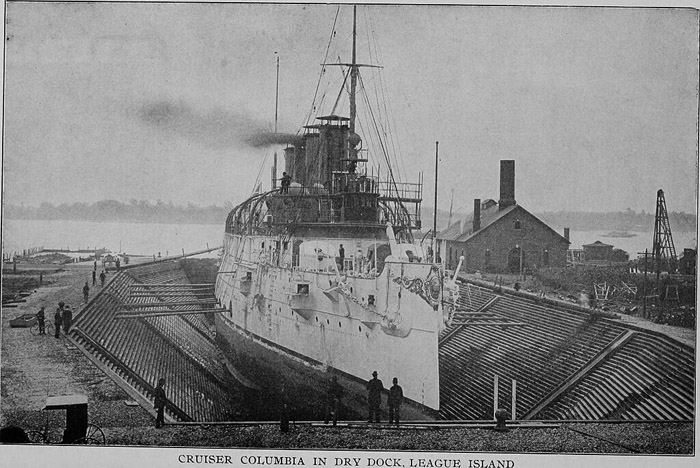
Columbia in drydock at League Island (Delaware)
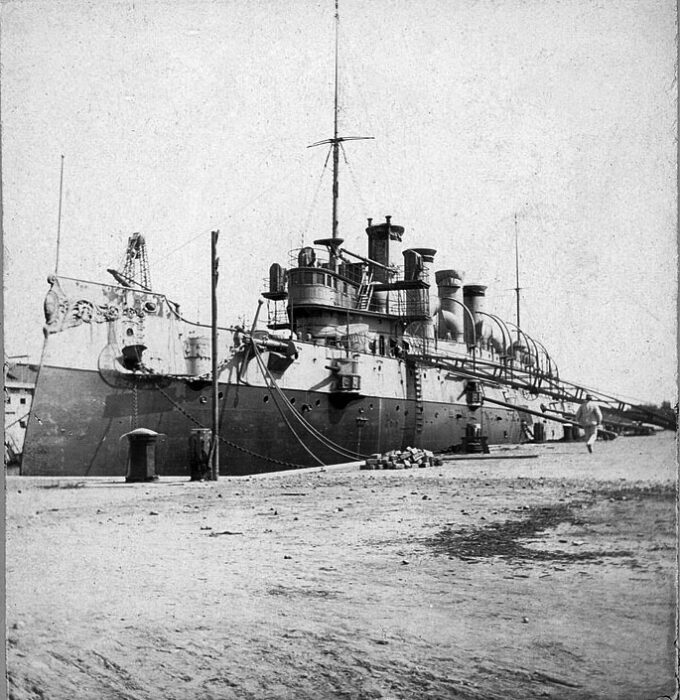
http://www.navsource.org/archives/04/c12/c12.htm
She was recommissioned a first time on 31 August 1902 to be a receiving ship at New York. By that time their commerce raiding concept was long gone and they were without clear purposes. From 9 November 1903 USS Columbian re-entered the Atlantic Training Squadron until decommissiond at Philadelphia (3 May 1907 until 22 June 1915). When recommissioned, she became a Submarine Flotilla flagship. She then swapped between several Atlantic submarine bases on inspection tours from April 1917.
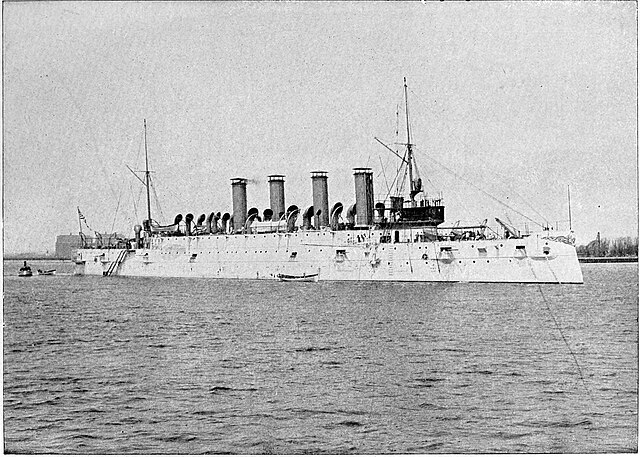
She patrolled off the Delaware Breakwater from 21 April as flagship, Squadron 5, Patrol Force and then was assigned the Cruiser Force as convoy escort. Her first voyage started on 1 January and she made four crossings until 13 November 1918 to protect the American Expeditionary Force to France. On 7 January 1919 she was flagship of Squadron 2, Destroyer Force on the East Coast-Caribbean. She was decommissioned a last time at Philadelphia NyD on 29 June 1921, reclassified CA-16 on 17 July 1920, renamed “Old Columbia” to free the name on 17 November 1921, and eventually sold 26 January 1922.


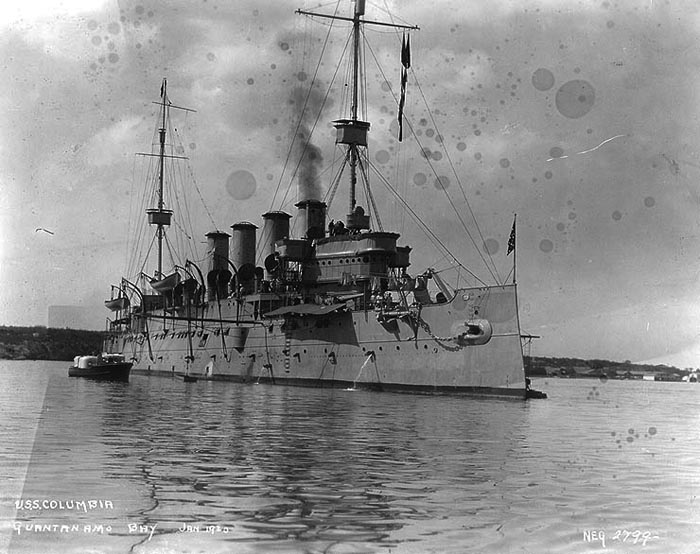
 USS Minneapolis (C-13)
USS Minneapolis (C-13)
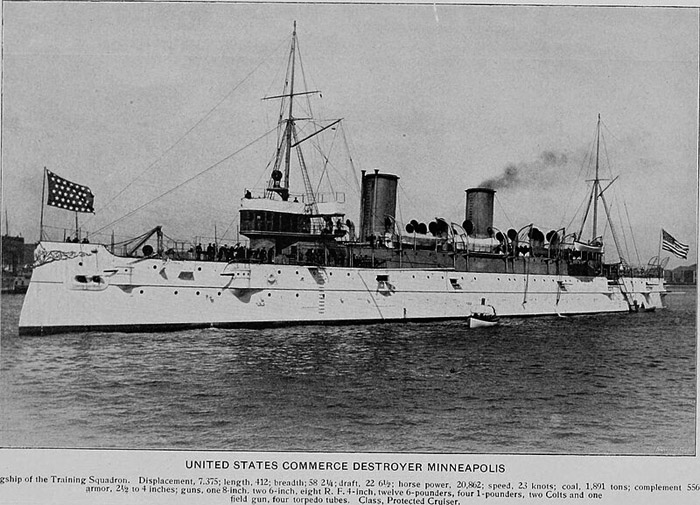
USS Minneapolis, booklet, official presentation
USS Minneapolis was also ordered and laid down at William Cramp & Sons. She was laid down on 16 December 1891, launched on 12 August 1893 and commissioned on 13 December 1894. Like her sister she two-funneled cruiser was assigned to the North Atlantic Squadron, for maneuvers and exercises along the eastern seaboard, basically from Canada to the Carribean. There, she join the European Squadron 27 November 1895. She sailed to Gibraltar and arrived on 13 December for a Mediterranean Sea deployment, which brought her all the way to the east, and back to Northern Europe, and the Baltic. She visited Kronstadt near St.Petersburg from 13 May to 19 June, as flagship, Rear Admiral Thomas O. Selfridge Jr. She represented the United States at the coronation of Czar Nicholas II. She went on touring northern Europe and returned in the Med to stops in Turkey and Greece, the back home via Gibraltar on 21 June 1897, arriving at Philadelphia on 6 July and placed in reserve at League Island Navy Yard in Philadelphia.
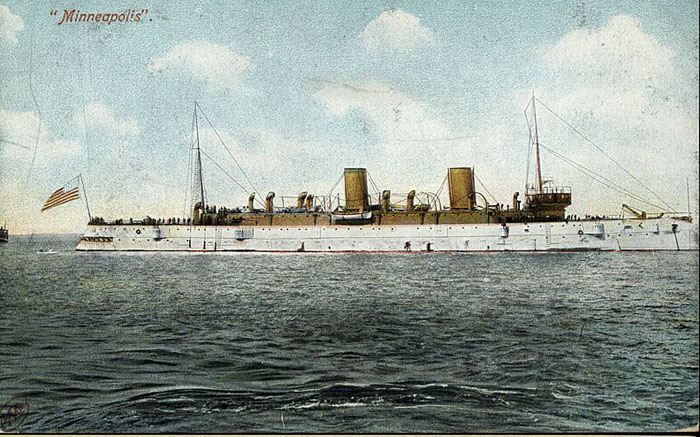
She was recommissioned in 1898 when the Spanish–American War broke out and assigned to the Northern Patrol Squadron, north Atlantic. In April 1898 she was sent to patrol the Carribean and try to find Admiral Cervera’s fleetbound for Cuba. She sailed down to the coast of Venezuela and then north to to Santiago de Cuba on 19 May 1898 en route to Key West. She did not took part in more operations and was decommissioned at Philadelphia on 18 August 1898, League Island Navy Yard. Like her sister she was recommissioned as receiving ship on 23 April 1902, decommissioned at League Island on 2 June 1903, recommissioned on 5 October for the Louisiana Purchase Celebration at New Orleans (16-28 December) and cruised the West Indies.
She was sent to New London on 23 May 1905 for the unveiling of the John Winthrop Monumen. Next she was in the Special Service Squadron with the collier Caesar and screw steamer Dixie (Rear Admiral Colby Mitchell Chester) for astronomical and scientific observations off Spain and Africa, desparting New York on 3 July 1905 for Gibraltar (17th) to observe the solar eclipse of 30 August. She left the the Mediterranean 10 November 1905 and sailed via France and England to Hampton Roads.
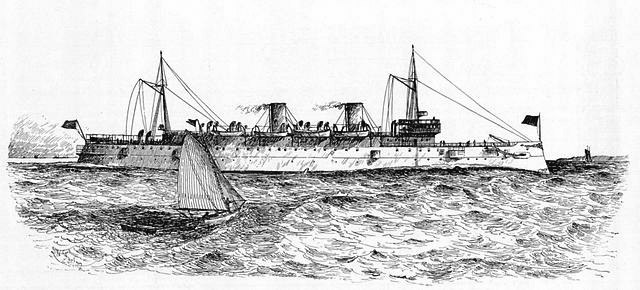
Then she was in Annapolis from 20 April to 5 May 1906, for ceremonies for the return of the body of John Paul Jones to the academy and sailed with midshipmen for a practice cruise, training later the naval militias of New York and Connecticut. She was decommissioned a last tilme at Philadelphia on 7 November 1906, in ordinary until April 1917. She was however recommissioned after modifications on 2 July, sailed to Hampton Roads, and departed on 26 October for Colon in the Panama Canal Zone, escorting the British transports Arawa and Corinthia from 6 November, bound for Halifax in Nova Scotia. Like her sister, USS Minneapolis was then assigned transatlantic convoy duty from 24 February 1918 and made four such missions over 8 months, usually from New York and stopped on arrival when the connvoys were turned over to British destroyers. Her last convoy was from 9 October for a convoy making almost a short trip to Nova Scotia, and back to New York on the 19th. She was then assigned to the Pacific Station as flagship, corssing Panama to arrive at San Diego on 7 February 1919. She was decommissioned at Mare Island Navy Yard on 15 March 1921, sold for BU on 5 August 192. Her mast icould be seen today at the northeastern shore of Bde Maka Sk (Lake Street boat launch) in Minneapolis and the bell at Minnetonka High School.
Read More/Src
Books
Bauer, K. Jack; Roberts, Stephen S. (1991). Register of Ships of the U.S. Navy, 1775–1990: Major Combatants. Greenwood Press.
Burr, Lawrence (2011). US Cruisers 1883-1904: The Birth of the Steel Navy. Osprey Publishing.
Friedman, Norman (1984). U.S. Cruisers: An Illustrated Design History. Annapolis, Maryland: Naval Institute Press.
Gardiner, Robert; Chesneau, Roger (1979). Conway’s All the World’s Fighting Ships 1860–1905.
Links
On navsource.org/
On history.navy.mil/
On hazegray.org/
On navypedia.org/
On spanamwar.com
on history.navy.mil/
on navsource.org/
Annual report of the Supervising Inspector General, Steamboat Inspection Service to the Secretary of Commerce 1896/97
navweaps.com 8-35_mk3.php
navweaps.com 5-40_mk2.php
navweaps.com/ WNUS_4-40_mk1.php
navweaps.com/ WNUS_3-50_mk2.php
navweaps.com 3-50_mk10-22.php
navweaps.com/ 6pounder_m1.php
navweaps.com 1pounder_m1
on navsource.org /c7.htm
history.navy.mil/ cincinnati-ii.html
on globalsecurity.org/
on en.wikipedia.org/
commons.wikimedia.org/ USS_Columbia_(C-12)
commons.wikimedia.org USS_Minneapolis_(C-13)



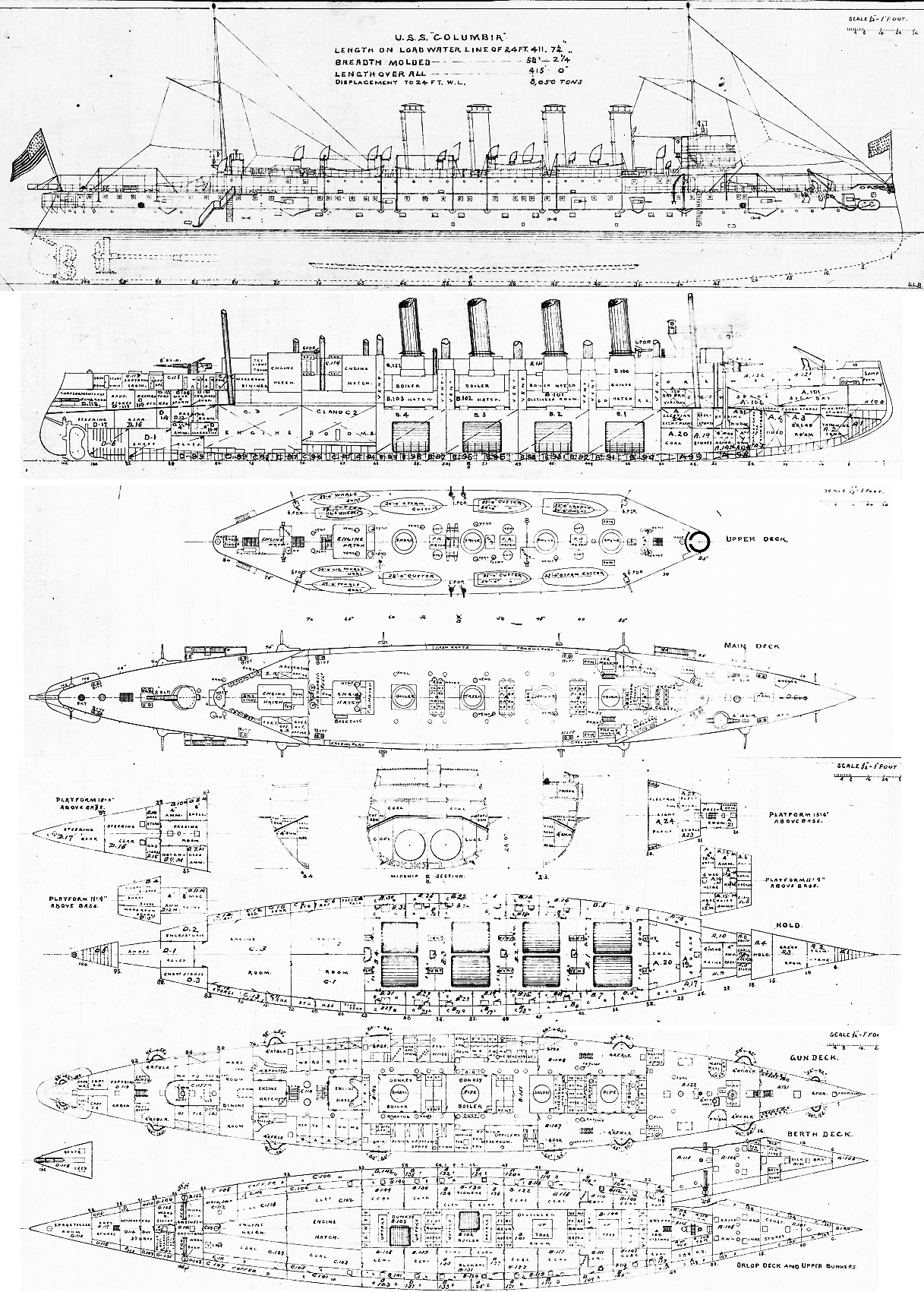
 Latest Facebook Entry -
Latest Facebook Entry -  X(Tweeter) Naval Encyclopedia's deck archive
X(Tweeter) Naval Encyclopedia's deck archive Instagram (@navalencyc)
Instagram (@navalencyc)





 French Navy
French Navy Royal Navy
Royal Navy Russian Navy
Russian Navy Armada Espanola
Armada Espanola Austrian Navy
Austrian Navy K.u.K. Kriegsmarine
K.u.K. Kriegsmarine Dansk Marine
Dansk Marine Nautiko Hellenon
Nautiko Hellenon Koninklije Marine 1870
Koninklije Marine 1870 Marinha do Brasil
Marinha do Brasil Osmanlı Donanması
Osmanlı Donanması Marina Do Peru
Marina Do Peru Marinha do Portugal
Marinha do Portugal Regia Marina 1870
Regia Marina 1870 Nihhon Kaigun 1870
Nihhon Kaigun 1870 Preußische Marine 1870
Preußische Marine 1870 Russkiy Flot 1870
Russkiy Flot 1870 Svenska marinen
Svenska marinen Søværnet
Søværnet Union Navy
Union Navy Confederate Navy
Confederate Navy Armada de Argentina
Armada de Argentina Imperial Chinese Navy
Imperial Chinese Navy Marinha do Portugal
Marinha do Portugal Mexico
Mexico Kaiserliche Marine
Kaiserliche Marine 1898 US Navy
1898 US Navy Sovietskiy Flot
Sovietskiy Flot Royal Canadian Navy
Royal Canadian Navy Royal Australian Navy
Royal Australian Navy RNZN Fleet
RNZN Fleet Chinese Navy 1937
Chinese Navy 1937 Kriegsmarine
Kriegsmarine Chilean Navy
Chilean Navy Danish Navy
Danish Navy Finnish Navy
Finnish Navy Hellenic Navy
Hellenic Navy Polish Navy
Polish Navy Romanian Navy
Romanian Navy Turkish Navy
Turkish Navy Royal Yugoslav Navy
Royal Yugoslav Navy Royal Thai Navy
Royal Thai Navy Minor Navies
Minor Navies Albania
Albania Austria
Austria Belgium
Belgium Columbia
Columbia Costa Rica
Costa Rica Cuba
Cuba Czechoslovakia
Czechoslovakia Dominican Republic
Dominican Republic Haiti
Haiti Hungary
Hungary Honduras
Honduras Estonia
Estonia Iceland
Iceland Eire
Eire Equador
Equador Iran
Iran Iraq
Iraq Latvia
Latvia Liberia
Liberia Lithuania
Lithuania Mandchukuo
Mandchukuo Morocco
Morocco Nicaragua
Nicaragua Persia
Persia San Salvador
San Salvador Sarawak
Sarawak Uruguay
Uruguay Venezuela
Venezuela Zanzibar
Zanzibar Warsaw Pact Navies
Warsaw Pact Navies Bulgaria
Bulgaria Hungary
Hungary

 Bundesmarine
Bundesmarine Dutch Navy
Dutch Navy Hellenic Navy
Hellenic Navy Marina Militare
Marina Militare Yugoslav Navy
Yugoslav Navy Chinese Navy
Chinese Navy Indian Navy
Indian Navy Indonesian Navy
Indonesian Navy JMSDF
JMSDF North Korean Navy
North Korean Navy Pakistani Navy
Pakistani Navy Philippines Navy
Philippines Navy ROKN
ROKN Rep. of Singapore Navy
Rep. of Singapore Navy Taiwanese Navy
Taiwanese Navy IDF Navy
IDF Navy Saudi Navy
Saudi Navy Royal New Zealand Navy
Royal New Zealand Navy Egyptian Navy
Egyptian Navy South African Navy
South African Navy






























 Ukrainian Navy
Ukrainian Navy dbodesign
dbodesign